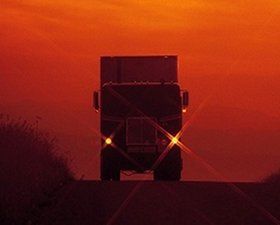Just A Tip For New Drivers Regarding Multi-stop Loads
Topic 20847 | Page 1

Good post Chris.
Since I routinely have three or more stops multiple seals are the norm. For OTR , definitely the exception.
OTR:
Over The Road
OTR driving normally means you'll be hauling freight to various customers throughout your company's hauling region. It often entails being gone from home for two to three weeks at a time.
I do a lot of multi-stop loads for 2 of our major customers. One shipper gives us seals for each stop and at the other we apply our own company seals.
In our loaded call macro we can only enter in 1 seal number, so in that case you would enter in the final drops seal number but not use it until you leave the stop inmediately prior to the final stop/consignee.
I just had to drop a trailer with a final still on it today at our Chicago terminal. The paperwork for that customer is sooooo bulky I put everything but the top Driver's copy of the bols for the final in the back of the trailer, apply the final seal, put the single drivers copy along with a little hand written note in the bill box telling them where everything is, so whoever does that last delivery knows exactly what I've done and where the thick Manila envelope with all the packing sheets and the final bol for the end customer is.
Consignee:
The customer the freight is being delivered to. Also referred to as "the receiver". The shipper is the customer that is shipping the goods, the consignee is the customer receiving the goods.
Shipper:
The customer who is shipping the freight. This is where the driver will pick up a load and then deliver it to the receiver or consignee.
Terminal:
A facility where trucking companies operate out of, or their "home base" if you will. A lot of major companies have multiple terminals around the country which usually consist of the main office building, a drop lot for trailers, and sometimes a repair shop and wash facilities.

It's a good idea to carry a bunch of seals anyway otr. It's pretty rare that a produce shipper in California provides a seal.
Shipper:
The customer who is shipping the freight. This is where the driver will pick up a load and then deliver it to the receiver or consignee.
OTR:
Over The Road
OTR driving normally means you'll be hauling freight to various customers throughout your company's hauling region. It often entails being gone from home for two to three weeks at a time.
It's my employer's requirement that we seal EVERY load so we all carry a large amount of company seals with us. Oh and we don't pull reefers. Mostly dry vans.
Dry Van:
A trailer or truck that that requires no special attention, such as refrigeration, that hauls regular palletted, boxed, or floor-loaded freight. The most common type of trailer in trucking.Reefer:
A refrigerated trailer.

You can haul some produce in a dry van lol. I've hauled for other shippers that don't provide seals, or extra seals for additional stops as well.
We always seal & lock as well, although I do occasionally see my brethren with no lock on their trailer. I personally feel that's crazy.
Shipper:
The customer who is shipping the freight. This is where the driver will pick up a load and then deliver it to the receiver or consignee.
Dry Van:
A trailer or truck that that requires no special attention, such as refrigeration, that hauls regular palletted, boxed, or floor-loaded freight. The most common type of trailer in trucking.
We always seal & lock as well, although I do occasionally see my brethren with no lock on their trailer. I personally feel that's crazy.
A padlock isn't going to stop someone who's truly determined to get into your trailer. I've seen it take less than a minute to cut through a padlock with a Dremel. Is it more secure than a flimsy piece of plastic? Yes. But where there's a will, there's a way. And also a line of relatives who want your share, but that's another discussion entirely.
We are requied to seal every load, weather one is given by the customer or not. We can get seals at every terminal. We also must have a lock on every trailer, empty or full. They can cut the steel the lock is on faster than the lock.
Terminal:
A facility where trucking companies operate out of, or their "home base" if you will. A lot of major companies have multiple terminals around the country which usually consist of the main office building, a drop lot for trailers, and sometimes a repair shop and wash facilities.

I've only hauled one load without a seal. It was a load of paper, and it was only a 200 mile run. 24,000 which is pretty light in my experience regarding rolls of paper. The shipper didn't require a seal, and since I wasn't gonna stop between the shipper and receiver I just ran it that way.
I always keep a handful of seals just in case.
Shipper:
The customer who is shipping the freight. This is where the driver will pick up a load and then deliver it to the receiver or consignee.
New Reply:
New! Check out our help videos for a better understanding of our forum features

















Preview:








 TT On Facebook
TT On Facebook
I've never ran into this before, but as they say, there's a first time for everything.
I picked up a load at one of our terminals. Another driver picked up from the shipper , and took the load to the terminal , and then my responsibility is to take the load to its 2 delivery stops.
When I got the paperwork from the terminal, I noticed there was not a seal left with it. Typically, on multi stop loads, the shipper will give you multiple seals, that you are to apply after each stop.
So you get to stop 1, break original seal according to receiver's instructions, unload, apply next seal, and go to next stop. Same for each additional stop.
So, I think that maybe the driver left the seal for stop 2 inside the trailer. No big deal. But, I can't check that until I break the seal at stop 1.
So I go and find my trailer, and do my pre-trip and verify the seal that is on the trailer matches the paperwork. Now, our trailers have 2 handles on the right hand side (passenger) door. I see that the driver that picked the load up, has put both seals on the door. One on each handle. So, when I get to stop 1, I have no choice but to break both seals, to open the doors.
Lesson 1: Always carry a handful of your own seals.
Lesson 2: On a multi stop load, only apply one seal between each stop. Unless a shipper specifies that seals are not necessary for the load, you should have a seal on each time you pull into a receiver.
Lesson 3: Communicate. Your paperwork will almost certainly have the seal number that corresponds to each stop, listed on the paperwork. So I sent a Qualcomm message, stating the problem, and that I would apply my own seal after stop 1, and note the paperwork accordingly. You don't want to simply apply a seal, and then the receiver at stop 2 ask for the seal, and it not match the paperwork.
I decided to write this, because it's something that I've never ran into before, and I'm assuming that the first driver just simply wasn't aware what the second seal was for. Hopefully this sheds a little light on one of the more uncommon things you'll run into as an OTR driver!
Shipper:
The customer who is shipping the freight. This is where the driver will pick up a load and then deliver it to the receiver or consignee.
Terminal:
A facility where trucking companies operate out of, or their "home base" if you will. A lot of major companies have multiple terminals around the country which usually consist of the main office building, a drop lot for trailers, and sometimes a repair shop and wash facilities.
OTR:
Over The Road
OTR driving normally means you'll be hauling freight to various customers throughout your company's hauling region. It often entails being gone from home for two to three weeks at a time.
Qualcomm:
Omnitracs (a.k.a. Qualcomm) is a satellite-based messaging system with built-in GPS capabilities built by Qualcomm. It has a small computer screen and keyboard and is tied into the truck’s computer. It allows trucking companies to track where the driver is at, monitor the truck, and send and receive messages with the driver – similar to email.